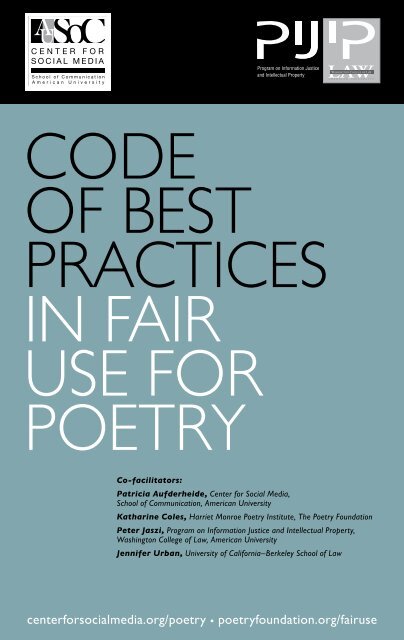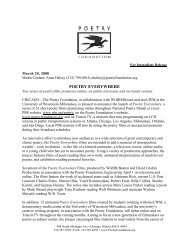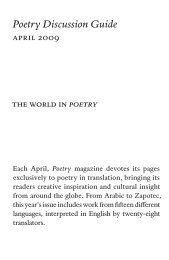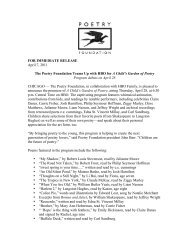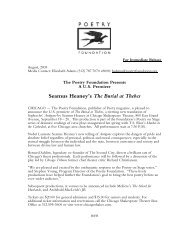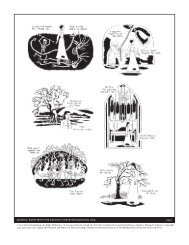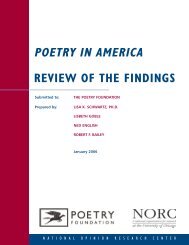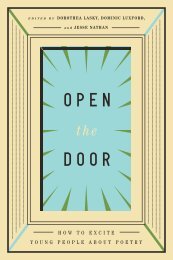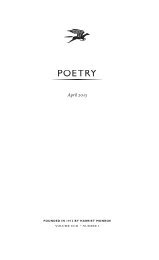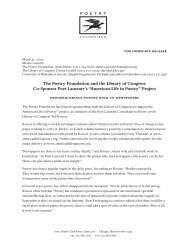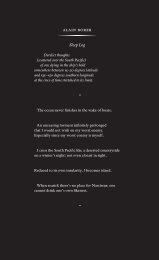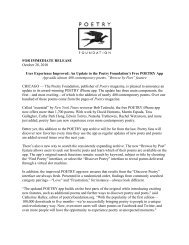Code of Best Practices in Fair Use for Poetry - Poetry Foundation
Code of Best Practices in Fair Use for Poetry - Poetry Foundation
Code of Best Practices in Fair Use for Poetry - Poetry Foundation
You also want an ePaper? Increase the reach of your titles
YUMPU automatically turns print PDFs into web optimized ePapers that Google loves.
CODE OF BEST PRACTICES IN FAIR USE FOR POETRYJanuary 2011INTRODUCTIONThe impetus <strong>for</strong> develop<strong>in</strong>g this code <strong>of</strong> best practices arose from a broaderconversation around poetry’s place <strong>in</strong> new media. Dur<strong>in</strong>g 2009, a group <strong>of</strong> poets,editors, publishers, and experts <strong>in</strong> copyright law and new media came togetherunder the auspices <strong>of</strong> the <strong>Poetry</strong> <strong>Foundation</strong>’s Harriet Monroe <strong>Poetry</strong> Institute withthe goal <strong>of</strong> identify<strong>in</strong>g obstacles prevent<strong>in</strong>g poetry from com<strong>in</strong>g fully <strong>in</strong>to new mediaand, where possible, imag<strong>in</strong><strong>in</strong>g how to remove or mitigate these obstacles. The group’swork culm<strong>in</strong>ated <strong>in</strong> a wide-rang<strong>in</strong>g report, “<strong>Poetry</strong> <strong>in</strong> New Media: A <strong>Use</strong>rs’ Guide”(http://www.poetryfoundation.org/foundation/newmediaproject.html).Embrac<strong>in</strong>g the overarch<strong>in</strong>g value <strong>of</strong> access to poetry as its theme, the group sawthat bus<strong>in</strong>ess, technological, and societal shifts had pr<strong>of</strong>ound implications <strong>for</strong>poets publish<strong>in</strong>g both <strong>in</strong> new and <strong>in</strong> traditional media, and also that poets have anopportunity to take a central role <strong>in</strong> expand<strong>in</strong>g access to a broad range <strong>of</strong> poetry <strong>in</strong>com<strong>in</strong>g months and years. Almost immediately, the group’s conversation focusedon barriers to poetic <strong>in</strong>novation and distribution caused by clearance issues. Some<strong>of</strong> these clearance issues develop from the bus<strong>in</strong>ess structures underly<strong>in</strong>g poetrypublish<strong>in</strong>g, but a significant number, the group discovered, relate to <strong>in</strong>stitutionalpractices that might be reconsidered, <strong>in</strong>clud<strong>in</strong>g both poets’ and publishers’approaches to quot<strong>in</strong>g and other types <strong>of</strong> possible fair use. Soon after its firstmeet<strong>in</strong>g, the group began discuss<strong>in</strong>g the possibility <strong>of</strong> develop<strong>in</strong>g “best practices”<strong>for</strong> poets and publishers.As the Harriet Monroe work<strong>in</strong>g group became aware <strong>of</strong> the uncerta<strong>in</strong>ties andtensions around fair use at play <strong>in</strong> the poetry community, its members realized thatthe poetry community urgently needed to clarify <strong>for</strong> itself what “best practices”might be <strong>for</strong> fair use <strong>in</strong> poetry. As the group was f<strong>in</strong>ish<strong>in</strong>g the new media report, theHMPI contacted Peter Jaszi and Patricia Aufderheide at American University, who(through the Center <strong>for</strong> Social Media and the Program on Intellectual Property andIn<strong>for</strong>mation Justice) have assisted various groups <strong>in</strong> develop<strong>in</strong>g fair use best practicesdocuments <strong>for</strong> their specific communities. Work<strong>in</strong>g with the two pr<strong>of</strong>essors andwith Jennifer Urban at University <strong>of</strong> Cali<strong>for</strong>nia–Berkeley, the HMPI supplementedthe already extensive <strong>in</strong><strong>for</strong>mation gather<strong>in</strong>g done <strong>for</strong> the new media report withan additional <strong>in</strong><strong>for</strong>mation-gather<strong>in</strong>g meet<strong>in</strong>g <strong>in</strong> Boston <strong>in</strong> November <strong>of</strong> 2009.The Center <strong>for</strong> Social Media and the HMPI then held six additional small group1
CODE OF BEST PRACTICES IN FAIR USE FOR POETRYmeet<strong>in</strong>gs, each with 10 to 20 participants—two at the 2009 MLA convention <strong>in</strong>Philadelphia, two at the 2010 AWP convention <strong>in</strong> Denver, and, <strong>in</strong> April 2010, twoat the <strong>Poetry</strong> <strong>Foundation</strong> <strong>of</strong>fices <strong>in</strong> Chicago.<strong>Poetry</strong> is more than a body <strong>of</strong> writ<strong>in</strong>gs or a typology <strong>of</strong> <strong>for</strong>ms; first and <strong>for</strong>emost,it is an evolv<strong>in</strong>g set <strong>of</strong> practices that engage, and are engaged by, the creative work<strong>of</strong> others. Dur<strong>in</strong>g the extensive conversations lead<strong>in</strong>g up to this document, a fewcentral themes about poetic practice emerged. The first was that poets generally(though not universally) want their poetry to be as widely available to potentialaudiences as possible, both dur<strong>in</strong>g their lifetimes and beyond. However, poets,especially those not work<strong>in</strong>g <strong>in</strong> and <strong>for</strong> new media <strong>for</strong>mats, expressed anxiety abouthow new media might affect their ability to make money from their work and toestablish and advance academic careers. And they were concerned about the easewith which new media enable others to distribute and alter their poems withoutpermission. At the same time, poets urgently expressed their need to use materialderived from the poems <strong>of</strong> others (<strong>in</strong>clud<strong>in</strong>g twentieth and twenty-first centurywriters) <strong>in</strong> their own work, and their desire to do so <strong>in</strong> ways that were both ethicallyand legally appropriate.<strong>Poetry</strong>, as a highly allusive art <strong>for</strong>m, fundamentally relies on the poet’s abilityto quote, to copy, and to “play” with others’ language, and poetry scholars andcommentators equally rely on their ability to quote the poetry they are discuss<strong>in</strong>g.In fact, poets generally acknowledge that essentially everyth<strong>in</strong>g they do <strong>in</strong> theirworkaday lives, from mak<strong>in</strong>g their poems to writ<strong>in</strong>g about poetry to teach<strong>in</strong>g poetry,builds on the work <strong>of</strong> others. In the group conversations, poets communicated ageneral sense that their ability to do their work with confidence was <strong>of</strong>ten impededby <strong>in</strong>stitutional regulations based on very straitened <strong>in</strong>terpretations <strong>of</strong> copyright.They lacked clear guidance as to what material might be available <strong>in</strong> the publicdoma<strong>in</strong>. Moreover, they were constra<strong>in</strong>ed by their own lack <strong>of</strong> certa<strong>in</strong>ty about whatuses are and are not fair with<strong>in</strong> the practices <strong>of</strong> poetry. While they certa<strong>in</strong>ly wish toappropriately control their own work, and to make money where money is to bemade, poets also expressed a strong wish to affirm the importance <strong>of</strong> their ability tomake reasonable unlicensed uses <strong>of</strong> copyrighted material and their support <strong>for</strong> suchuses by others <strong>of</strong> their own works. In this, the poets both exemplified the tensions<strong>in</strong>herent <strong>in</strong> copyright law and the fair use doctr<strong>in</strong>e and heartily endorsed the valuesundergird<strong>in</strong>g fair use.2
CODE OF BEST PRACTICES IN FAIR USE FOR POETRYTHE GOALS OF THIS DOCUMENT<strong>Fair</strong> use is widely and vigorously employed <strong>in</strong> many pr<strong>of</strong>essional communities.For example, historians regularly quote both other historians’ writ<strong>in</strong>gs and textualsources; filmmakers and visual artists use, re<strong>in</strong>terpret, and critique copyrightedmaterial; scholars illustrate cultural commentary with textual, visual, and musicalexamples. <strong>Fair</strong> use is also healthy and vigorous <strong>in</strong> broadcast news and othercommercial media, where references to popular films, classic TV programs, archivalimages, and popular songs are frequently unlicensed.Some <strong>of</strong> these other pr<strong>of</strong>essional communities have also set <strong>for</strong>th their understand<strong>in</strong>gs<strong>in</strong> consensus documents that may be useful to poets, teachers, scholars, and others<strong>in</strong>volved with creative practices. Although specific groups create such codes, no oneneeds to be a member <strong>of</strong> any pr<strong>of</strong>essional group to benefit from their <strong>in</strong>terpretations.What follows is a code <strong>of</strong> best practices devised specifically by and <strong>for</strong> the poetrycommunity. It is meant to enhance the ability <strong>of</strong> poets, teachers, scholars, and othersto rely on fair use by serv<strong>in</strong>g as documentation <strong>of</strong> commonly held understand<strong>in</strong>gsabout best practices <strong>in</strong> fair use drawn from the experience <strong>of</strong> the poetry communityitself and supported by legal analysis. The code is meant as both an illustration<strong>of</strong> and a guide to which uses <strong>of</strong> copyrighted materials, as described below, areconsidered reasonable and appropriate with<strong>in</strong> the poetry community.HOW THIS DOCUMENT WAS CREATEDPoets work<strong>in</strong>g <strong>in</strong> traditional <strong>for</strong>ms and those explor<strong>in</strong>g new media were bothstrongly represented <strong>in</strong> the small group discussions. In each conversation,participants were asked to discuss a series <strong>of</strong> brief hypothetical examples designedto raise questions about fair use and its limitations. As the conversations revealed,members <strong>of</strong> this community believe both <strong>in</strong> copyright as an important source <strong>of</strong>protection <strong>for</strong> poets and <strong>in</strong> the importance <strong>of</strong> access to copyrighted material asa factor <strong>in</strong> enabl<strong>in</strong>g learn<strong>in</strong>g and new creativity. Their understand<strong>in</strong>g <strong>of</strong> fair use,represented below, is grounded <strong>in</strong> this balanced understand<strong>in</strong>g <strong>of</strong> copyright law.To ensure the legal validity <strong>of</strong> those conclusions, this document was reviewed byan outside panel <strong>of</strong> three dist<strong>in</strong>guished copyright experts.3
CODE OF BEST PRACTICES IN FAIR USE FOR POETRYsimple politeness to seek permission <strong>for</strong> use, even when the use could be madewithout it. By the same token, members <strong>of</strong> the poetry community also recognizethat there may be special circumstances <strong>in</strong> which it would be difficult or impossibleto request permission <strong>in</strong> advance <strong>of</strong> use. In addition, they also understand that alegal rationale <strong>for</strong> fair use will apply with undim<strong>in</strong>ished <strong>for</strong>ce even when permissionhas not been requested or has been denied.This code applies to activities <strong>of</strong> us<strong>in</strong>g the copyrighted material <strong>in</strong> question <strong>in</strong>the United States, regardless <strong>of</strong> where <strong>in</strong> the world it orig<strong>in</strong>ates. Copyright lawis territorial is scope, and most other countries do not recognize fair use as such,although most have some exceptions <strong>for</strong> uses <strong>of</strong> copyrighted works built <strong>in</strong>to theirnational laws.F<strong>in</strong>ally, although the code <strong>in</strong>corporates consensus-based community standards thatare consistent with current U.S. law and its prevail<strong>in</strong>g <strong>in</strong>terpretation by U.S. courts,it is not a comprehensive or exhaustive guide to all possible applications <strong>of</strong> fair use <strong>in</strong>and around poetry—even <strong>in</strong> the recurrent situations detailed below. Individuals maybe able to make persuasive arguments <strong>for</strong> fair use even where they go beyond theshared norms expressed here. Moreover, this dynamic legal doctr<strong>in</strong>e will cont<strong>in</strong>ue toevolve along with poetic, scholarly, and artistic practice.INFORMATION ABOUT COPYRIGHT AND FAIR USELaw provides copyright protection to creative works <strong>in</strong> order to foster the creation<strong>of</strong> culture and the discussion <strong>of</strong> ideas. Its best known feature is protection <strong>of</strong> owners’rights. But copy<strong>in</strong>g, quot<strong>in</strong>g, and generally re-us<strong>in</strong>g exist<strong>in</strong>g cultural material canbe, under some circumstances, a critically important part <strong>of</strong> generat<strong>in</strong>g new cultureand promot<strong>in</strong>g <strong>in</strong>tellectual exchange. In fact, the cultural value <strong>of</strong> copy<strong>in</strong>g is so wellestablished that it is written <strong>in</strong>to the social barga<strong>in</strong> at the heart <strong>of</strong> copyright law. Thebarga<strong>in</strong> is this: we as a society give limited property rights to creators to encouragethem to produce culture; at the same time, we guarantee that all works eventually willbecome part <strong>of</strong> the public doma<strong>in</strong> and, <strong>in</strong> the meantime, we give other creators andspeakers the opportunity to use copyrighted material without permission or payment<strong>in</strong> some circumstances. Without the second half <strong>of</strong> the barga<strong>in</strong>, we could all loseimportant new cultural work and impoverish public discourse.6
CODE OF BEST PRACTICES IN FAIR USE FOR POETRY• Was the material taken appropriate <strong>in</strong> k<strong>in</strong>d and amount, consider<strong>in</strong>g the nature<strong>of</strong> the copyrighted work and <strong>of</strong> the use?If the answers to these two questions are “yes,” a court is likely to f<strong>in</strong>d a use fair.Because that is true, such a use is also less likely to be challenged than other types<strong>of</strong> uses.Both key questions touch on, among other th<strong>in</strong>gs, the question <strong>of</strong> whether the usewill cause excessive economic harm to the copyright owner. Courts have told us thatcopyright owners aren’t entitled to an absolute monopoly over trans<strong>for</strong>mative uses <strong>of</strong>their works. By the same token, however, when a use supplants a copyright owner’score market, it is unlikely to be fair. Thus, <strong>for</strong> example, a textbook author cannotquote large parts <strong>of</strong> a competitor’s book merely to avoid the trouble <strong>of</strong> writ<strong>in</strong>gher own exposition. Yet another consideration <strong>in</strong>fluenc<strong>in</strong>g the way <strong>in</strong> which thesequestions are analyzed is whether the user acted reasonably and <strong>in</strong> good faith <strong>in</strong> light<strong>of</strong> standards <strong>of</strong> accepted practice <strong>in</strong> his or her particular field.BEST PRACTICESGENERAL POINTS ABOUT THE PRINCIPLESThis code <strong>of</strong> best practices identifies seven sets <strong>of</strong> common current practices <strong>in</strong> theuse <strong>of</strong> copyrighted materials <strong>in</strong> and around poetry—“Pr<strong>in</strong>ciples”—to which thedoctr<strong>in</strong>e <strong>of</strong> fair use clearly applies. It does not exhaust the full range <strong>of</strong> situations <strong>in</strong>which unlicensed use <strong>of</strong> copyrighted material by poets, teachers, scholars, and othersmay be considered fair use. Not only will there be circumstances today <strong>in</strong> whichparticular uses not covered by this code would be fair, but as the field evolves, newsets <strong>of</strong> such circumstances will arise.In general, the situations identified <strong>in</strong>volve uses <strong>in</strong> all <strong>for</strong>ms <strong>of</strong> media. Except asotherwise <strong>in</strong>dicated, a digital copy is the same as an analog or paper one <strong>for</strong> purposes<strong>of</strong> fair use. The situations concern the unlicensed fair use <strong>of</strong> copyrighted materials,not the way the copy from which the user works was acquired. When a user’s copywas obta<strong>in</strong>ed illegally or <strong>in</strong> bad faith, that fact may negatively affect fair use analysis;similarly, special restrictions (such as conditions on the use <strong>of</strong> archival material) maycircumscribe fair use.8
CODE OF BEST PRACTICES IN FAIR USE FOR POETRYThe pr<strong>in</strong>ciples are all subject to a “rule <strong>of</strong> proportionality.” The fair use rights <strong>of</strong>poets, teachers, scholars, and others extend to the portions <strong>of</strong> copyrighted works thatthey need to accomplish their goals. Thus, while <strong>in</strong> some cases fair use may extendto an entire work, <strong>in</strong> others relatively brief portions may constitute “too much.”Importantly, there are no numerical rules <strong>of</strong> thumb that can be relied upon <strong>in</strong>determ<strong>in</strong><strong>in</strong>g whether a use is fair.PRINCIPLES AND LIMITATIONS1. PARODY AND SATIREDESCRIPTION: Although judges sometimes dist<strong>in</strong>guish parody and satire, both are<strong>for</strong>ms <strong>of</strong> commentary achieved by non-literal imitation <strong>of</strong> previous work, <strong>in</strong>clud<strong>in</strong>gpoetry. Such imitation (<strong>of</strong>ten with a humorous edge) can be a way to expressappreciation <strong>of</strong> or affiliation with a poet or a body <strong>of</strong> work; members <strong>of</strong> the poetrycommunity felt strongly that there was no rational basis on which to discrim<strong>in</strong>atebetween adverse and friendly imitation. Likewise, satiric imitations <strong>of</strong> well-knownpoems are an effective tool <strong>for</strong> add<strong>in</strong>g to the overall common stock <strong>of</strong> mean<strong>in</strong>g, andneed not detract from the value <strong>of</strong> the poetry employed.PRINCIPLE: Under fair use, a poet may adapt a poem or a portion <strong>of</strong> a poem <strong>in</strong>order to (1) <strong>of</strong>fer a direct or <strong>in</strong>direct critique <strong>of</strong> that poem, its author, or its genre;(2) present a genu<strong>in</strong>e homage to a poet or genre; or (3) hold up to ridicule a social,political, or cultural trend or phenomenon.LIMITATIONS:• Poets should provide attribution to sources, accord<strong>in</strong>g to the conventionsappropriate to the use <strong>in</strong> question, unless the orig<strong>in</strong>al is readily recognizable bythe <strong>in</strong>tended audience.• Poets should avoid slavish imitation <strong>of</strong> source material, <strong>in</strong> which the re-use addsno significant value to the orig<strong>in</strong>al.• If use <strong>of</strong> type (3) occurs <strong>in</strong> the context <strong>of</strong> an anthology or other collection <strong>of</strong>similar material, the author or editor generally should take care that the sourcematerial is drawn from a range <strong>of</strong> different poets’ work, unless a focus on oneor a small number is appropriate to the purpose <strong>of</strong> the collection.9
CODE OF BEST PRACTICES IN FAIR USE FOR POETRYPRINCIPLE: Under fair use, <strong>in</strong>structors at all levels who devote class time to teach<strong>in</strong>gexamples <strong>of</strong> published poetry may reproduce those poems fully or partially <strong>in</strong> theirteach<strong>in</strong>g materials and make them available to students us<strong>in</strong>g the conventionaleducational technologies most appropriate <strong>for</strong> their <strong>in</strong>structional purposes.LIMITATIONS:• This pr<strong>in</strong>ciple does not apply to the preparation or distribution <strong>of</strong> publishedor commercially distributed teach<strong>in</strong>g materials <strong>in</strong>clud<strong>in</strong>g anthologies andtextbooks.• Quoted passages should be reproduced as accurately as possible, and ascompletely as necessary, to reflect the creative choices embodied <strong>in</strong> the poem.• Teachers should provide conventional attribution <strong>for</strong> the passages reproduced.• Teachers should limit reproductions <strong>of</strong> long poems to the portions actuallytaught and appropriate context surround<strong>in</strong>g those portions.• Teachers’ selections <strong>of</strong> poems should not substantially duplicate those <strong>of</strong>exist<strong>in</strong>g, commercially available anthologies or textbooks.• Teachers should avoid reproduc<strong>in</strong>g all or most <strong>of</strong> the contents <strong>of</strong> a volume <strong>of</strong>poetry that is reasonably available <strong>for</strong> purchase by students.4. CRITICISM, COMMENT, ILLUSTRATIONDESCRIPTION: Poetic quotations are frequently employed by writers and artists <strong>in</strong>other discipl<strong>in</strong>es. Perhaps the most non-controversial example is that <strong>in</strong> which ascholar, critic, or reviewer quotes from a poem <strong>in</strong> order to make a po<strong>in</strong>t about thepoet <strong>in</strong> question or about his or her work. Because poetry arises out <strong>of</strong> and speaks tothe particular circumstances (social, cultural, economic) <strong>of</strong> its writ<strong>in</strong>g, members <strong>of</strong>the poetry community were also united <strong>in</strong> their op<strong>in</strong>ion that scholars and creators <strong>in</strong>other fields should be entitled to use apt selections <strong>of</strong> poetry <strong>for</strong> purposes other thancriticism. Thus, they were supportive <strong>of</strong> quotation both <strong>for</strong> textual “illustration” and<strong>in</strong> the practice <strong>of</strong> visual artists who take <strong>in</strong>spiration from poetic works.PRINCIPLE: Under fair use, a critic discuss<strong>in</strong>g a published poem or body <strong>of</strong> poetrymay quote freely as justified by the critical purpose; likewise, a commentator mayquote to exemplify or illum<strong>in</strong>ate a cultural/historical phenomenon, and a visualartist may <strong>in</strong>corporate relevant quotations <strong>in</strong>to his or her work.11
CODE OF BEST PRACTICES IN FAIR USE FOR POETRYLIMITATIONS:• This pr<strong>in</strong>ciple does not apply to reproductions <strong>in</strong> textbooks and anthologieswhere quotations appear without an <strong>in</strong>dependent critical apparatus.• Quoted passages should be reproduced as accurately as possible to reflect, andnot so m<strong>in</strong>imally or selectively as to mislead about, creative choices embedded<strong>in</strong> the poem.• Critics, commentators, and artists should provide conventional attribution <strong>for</strong>their chosen quotations.• They should also have an articulable rationale <strong>for</strong> the relevance <strong>of</strong> their chosenquotations to their own work.• Likewise, the extent <strong>of</strong> quotation should be appropriate to the purpose <strong>of</strong> the use.• <strong>Use</strong>s that are solely “decorative” or “enterta<strong>in</strong><strong>in</strong>g” should be avoided.• Permissible quotations used <strong>for</strong> exemplary purposes generally should be brieferthan those used <strong>for</strong> critical purposes.• Visual artists generally should not <strong>in</strong>corporate entire poems <strong>in</strong> a merelydecorative fashion without the copyright holder’s permission.5. EPIGRAPHSDESCRIPTION: The use <strong>of</strong> quotations from poems to <strong>in</strong>troduce chapters or sections <strong>of</strong>other works is a time-honored literary practice. Generally speak<strong>in</strong>g, these quotationsare selected <strong>for</strong> the connection to the text <strong>in</strong> question, although occasionally they maybe <strong>in</strong>troduced <strong>for</strong> merely frivolous or decorative purposes. Members <strong>of</strong> the poetrycommunity generally found this practice to be non-controversial.PRINCIPLE: Under fair use, an author may use brief quotations <strong>of</strong> poetry to <strong>in</strong>troducechapters and sections <strong>of</strong> a prose work or long poem, so long as there is an articulablerelationship between the quotation and the content <strong>of</strong> the section <strong>in</strong> question.LIMITATIONS:• Quoted passages should be reproduced as accurately as possible to reflect thepoet’s underly<strong>in</strong>g creative choices, except to the extent that modification isspecifically justified by the purpose <strong>of</strong> the use.• Authors should provide conventional attribution to sources unless the orig<strong>in</strong>alis readily recognizable by the <strong>in</strong>tended audience or the absence <strong>of</strong> properattribution is justified by the purpose <strong>of</strong> the use.12
CODE OF BEST PRACTICES IN FAIR USE FOR POETRY• Nor is the mere assertion <strong>of</strong> the compiler’s admiration <strong>for</strong> or personalassociation with a particular passage or poem <strong>in</strong>dependently sufficient tojustify <strong>in</strong>clusion.• A blogger quot<strong>in</strong>g a poem <strong>in</strong> a blog should use only as much <strong>of</strong> the poem asis necessary to the blogger’s specific goals, whether the purpose is provid<strong>in</strong>gcommentary or mak<strong>in</strong>g some other discursive po<strong>in</strong>t.• <strong>Poetry</strong> sites should <strong>for</strong>mulate and enact policies to provide <strong>for</strong> prompt andreasonable responses to objections by poets (or their qualified successors) toeither the fact or the <strong>for</strong>m <strong>of</strong> any use.7. LITERARY PERFORMANCEDESCRIPTION: Live read<strong>in</strong>gs are a staple <strong>of</strong> the poetry scene <strong>in</strong> many communitiesacross the United States. Frequently, readers are poets whose programs <strong>in</strong>clude boththeir own work and selections from the work <strong>of</strong> others. On occasion, poets andother readers also create programs that consist primarily <strong>of</strong> the work <strong>of</strong> poets theyadmire. On some occasions, these read<strong>in</strong>gs may constitute criticism or commentaryon the works <strong>in</strong>cluded, but that will not always be the case. Members <strong>of</strong> the poetrycommunity strongly believe <strong>in</strong> the value <strong>of</strong> respect <strong>for</strong> poets and their work, andthey generally agree that prior consent should when possible be obta<strong>in</strong>ed <strong>for</strong> the<strong>in</strong>clusion <strong>of</strong> particular poems <strong>in</strong> read<strong>in</strong>gs.PRINCIPLE: Under fair use, a person other than the poet may read a poem to a liveaudience, even <strong>in</strong> circumstances where the doctr<strong>in</strong>e otherwise would not apply, ifthe context is (1) a read<strong>in</strong>g <strong>in</strong> which the reader’s own work also is <strong>in</strong>cluded, or (2) aread<strong>in</strong>g primarily <strong>in</strong>tended to celebrate the poet <strong>in</strong> question.LIMITATIONS:• Readers should present quoted passages or poems as accurately as possible,allow<strong>in</strong>g <strong>for</strong> the nature <strong>of</strong> the per<strong>for</strong>mance event.• Readers should provide conventional attribution to source material asappropriate to the nature <strong>of</strong> the per<strong>for</strong>mance event.• Readers should refra<strong>in</strong> from the use <strong>of</strong> particular poems <strong>in</strong> an event if they areaware that the context would be (or would have been) objectionable to thepoet, unless the use is permissible as commentary or criticism.14
CODE OF BEST PRACTICES IN FAIR USE FOR POETRY• Subject to the same qualification, readers should not repeat uses to which thepoet (or a qualified successor) has objected.• In events <strong>of</strong> type (1), readers should avoid disproportionate use <strong>of</strong> the workby one or a few poets <strong>in</strong> any particular read<strong>in</strong>g; <strong>in</strong> events <strong>of</strong> type (2), readersshould limit their reliance on fair use to one-time or occasional per<strong>for</strong>mances.• Read<strong>in</strong>gs that <strong>in</strong>clude unauthorized copyrighted poetry may be recorded <strong>for</strong>archival purposes but not be made generally available without permission fromthe poet (or qualified successor).15
CODE OF BEST PRACTICES IN FAIR USE FOR POETRYProgram on In<strong>for</strong>mation Justiceand Intellectual PropertyThe Program on In<strong>for</strong>mation Justice and Intellectual Property, led by Pr<strong>of</strong>essor Peter Jaszi,promotes social justice <strong>in</strong> law govern<strong>in</strong>g <strong>in</strong><strong>for</strong>mation dissem<strong>in</strong>ation and <strong>in</strong>tellectual property throughresearch, scholarship, public events, advocacy, and provision <strong>of</strong> legal and consult<strong>in</strong>g services. Theprogram is a project <strong>of</strong> the Wash<strong>in</strong>gton College <strong>of</strong> Law at American University <strong>in</strong> Wash<strong>in</strong>gton, D.C.,led by Dean Claudio Grossman.The Center <strong>for</strong> Social Media, led by Pr<strong>of</strong>essor Patricia Aufderheide, showcases and analyzes media<strong>for</strong> social justice, civil society, and democracy, and the public environment that nurtures them.The center is a project <strong>of</strong> the School <strong>of</strong> Communication, led by Dean Larry Kirkman, at AmericanUniversity <strong>in</strong> Wash<strong>in</strong>gton, D.C.The Harriet Monroe <strong>Poetry</strong> Institute is an <strong>in</strong>dependent <strong>for</strong>um created by the <strong>Poetry</strong> <strong>Foundation</strong> toprovide a space <strong>in</strong> which fresh th<strong>in</strong>k<strong>in</strong>g about poetry, <strong>in</strong> both its <strong>in</strong>tellectual and its practical needs,can flourish free <strong>of</strong> any allegiance other than to the best ideas. The <strong>in</strong>stitute convenes lead<strong>in</strong>gpoets, scholars, publishers, educators, and other th<strong>in</strong>kers from <strong>in</strong>side and outside the poetry worldto address issues <strong>of</strong> importance to the art <strong>for</strong>m <strong>of</strong> poetry and to identify and champion solutions <strong>for</strong>the benefit <strong>of</strong> the art.Funded by The <strong>Poetry</strong> <strong>Foundation</strong>.Feel free to reproduce this work <strong>in</strong> its entirety. For excerpts and quotations, depend upon fair use.center<strong>for</strong>socialmedia.org/poetry • poetryfoundation.org/fairuse16
LEGAL ADVISORY BOARDPr<strong>of</strong>essor Michael J. Madison, University <strong>of</strong> Pittsburgh School <strong>of</strong> LawGloria C. Phares, Esq., Patterson Belknap Webb & TylerPr<strong>of</strong>essor Elizabeth Townsend-Gard, Tulane University School <strong>of</strong> LawFor cultural and literary advice, the co-facilitators also thank Lewis Hyde,Thomas Pr<strong>of</strong>essor <strong>of</strong> Creative Writ<strong>in</strong>g at Kenyon College and a facultyassociate at the Berkman Center, Harvard University.An equal opportunity, affirmative action university. UP11-360


